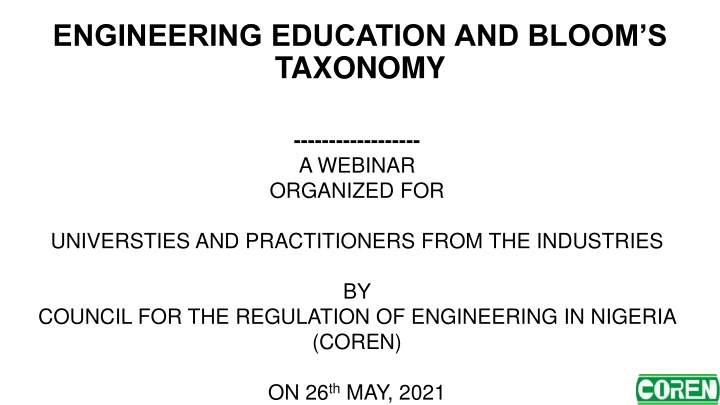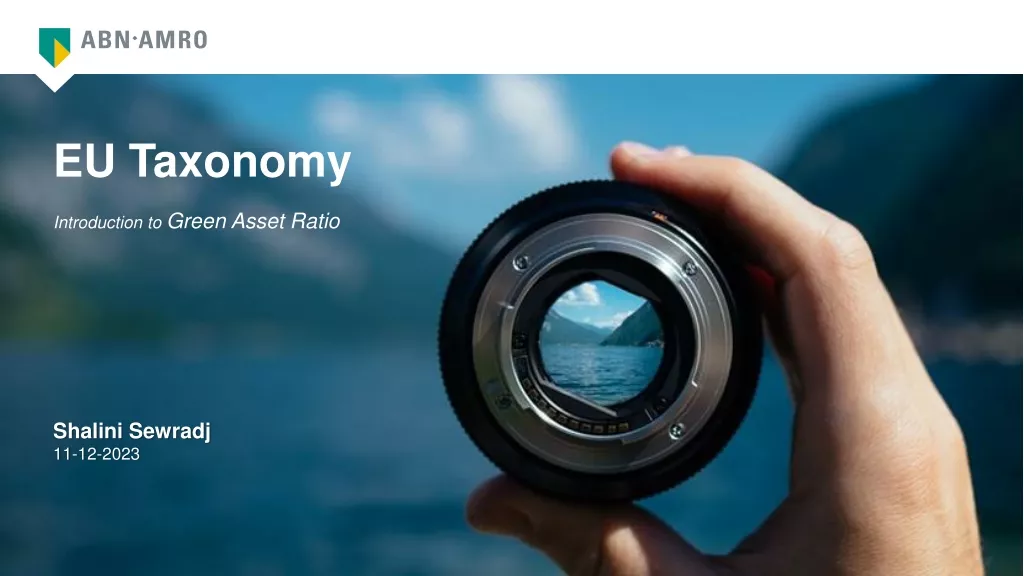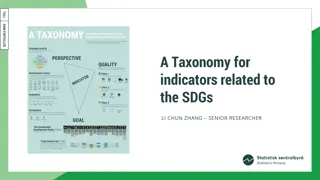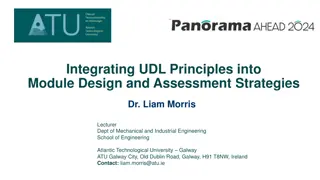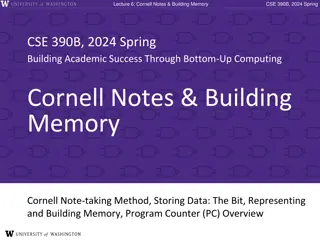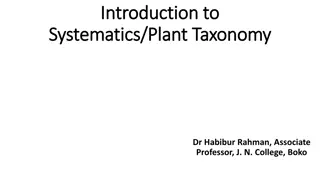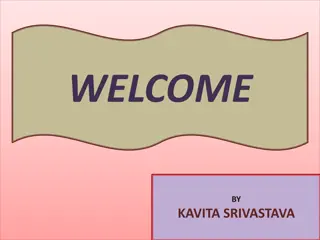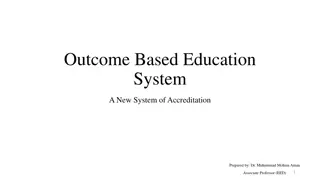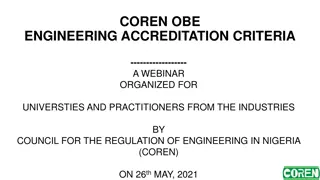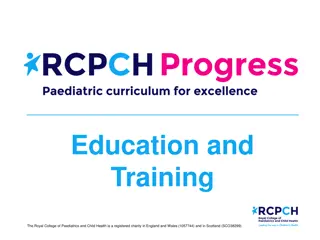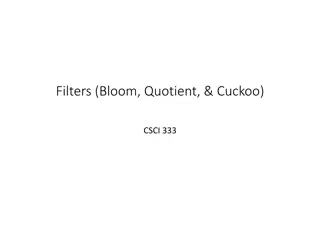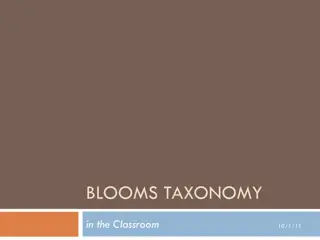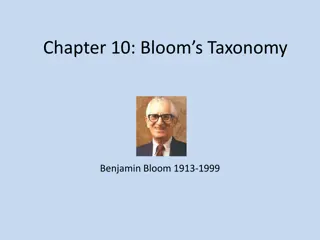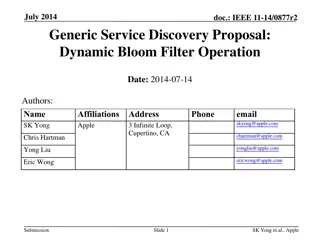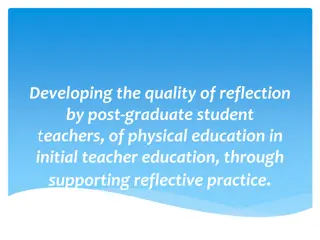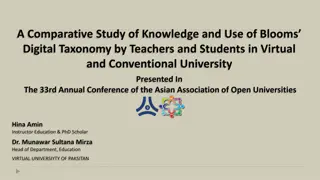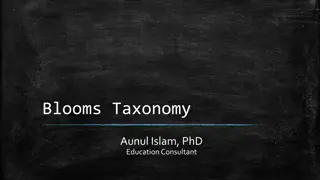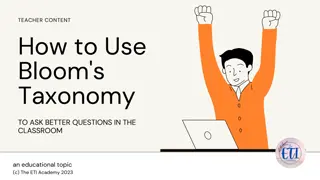Enhancing Engineering Education with Bloom's Taxonomy: A COREN Webinar Overview
Explore the application of Bloom's Taxonomy in engineering education, focusing on understanding, analyzing, and improving the curriculum for Nigerian universities. Learn how this framework promotes critical thinking and guides assessment practices to elevate educational outcomes.
Download Presentation

Please find below an Image/Link to download the presentation.
The content on the website is provided AS IS for your information and personal use only. It may not be sold, licensed, or shared on other websites without obtaining consent from the author.If you encounter any issues during the download, it is possible that the publisher has removed the file from their server.
You are allowed to download the files provided on this website for personal or commercial use, subject to the condition that they are used lawfully. All files are the property of their respective owners.
The content on the website is provided AS IS for your information and personal use only. It may not be sold, licensed, or shared on other websites without obtaining consent from the author.
E N D
Presentation Transcript
ENGINEERING EDUCATION AND BLOOMS TAXONOMY ------------------ A WEBINAR ORGANIZED FOR UNIVERSTIES AND PRACTITIONERS FROM THE INDUSTRIES BY COUNCIL FOR THE REGULATION OF ENGINEERING IN NIGERIA (COREN) ON 26th MAY, 2021
OUTCOMES OF THE WEBINAR At the end of this webinar, participants are expected to: 1. understand Bloom s taxonomy and its importance. 2. analyse and evaluate the present Engineering education curriculum. 3. apply Bloom s taxonomy to develop a better Engineering education in Nigerian Universities.
SECTION A BLOOM S TAXONOMY
BLOOMS TAXONOMY Bloom's taxonomy was created in 1956 under the leadership of Dr. Benjamin Bloom in order to promote higher forms of thinking in education. They identified levels of actions that describe and classify observable knowledge, skills, attitudes, behaviours and abilities which became taxonomy with three overlapping domains: The Cognitive domain deals with the intellectual development The Affective domain deals with the development of feelings and attitudes The Psychomotor domain deals with motor skills development . Bloom's taxonomy is one of the most recognized and used educational tools that attempts to move students beyond simple memorization.
BLOOMS TAXONOMY Bloom s taxonomy can be used as a potential model for framing educational objectives within a course and as a guide to structure activities and assessment based on learning goals. Bloom s taxonomy help us not only in designing curriculum and teaching, but also to designappropriate examination questions belonging to various cognitive levels In 2001, Anderson and Krathwohl modified Bloom s taxonomy to make it relevant to the present-day requirements
BLOOMS TAXONOMY Action Verbs for Assessment: Educators have come up with taxonomy of measurable verbs corresponding to each of the Bloom s cognitive levels. Action verbs in preparing assessment questions are most important. Action verbs are indicators of the complexity (level) of question.
BLOOMS TAXONOMY Action Verbs for Assessment of Cognitive Domain: Level Skill Demonstrated Sample Behavioral Verbs list, define, describe, recite, recall, identify, show, tabulate, quote, name, who, when, where Ability to recall information like facts, conventions, definitions, technical terms, classifications, categories, and criteria. Ability to recall procedures, abstractions, principles and theories in the field Knowledge of date, events, and places Mastery of subject matter tell, label, methodology and 1.Remember
BLOOMS TAXONOMY Action Verbs for Assessment of Cognitive Domain: Level Skill Demonstrated understanding information grasp meaning translate knowledge into new context interpret facts, compare, contrast order, group, infer, cause Predict consequences Sample Behavioral Verbs describe, explain, paraphrase, restate, associate, contrast, summarize, differentiate, interprete, discuss 2. Understand
BLOOMS TAXONOMY Action Verbs for Assessment of Cognitive Domain: Level Skill Demonstrated use information use methods, theories in new situations solve problems using required skills or knowledge demonstrating correct usage of a method or procedure Sample Behavioral Verbs calculate, predict, apply, solve, Illustrate, use, demonstrate, determine, model, experiment, show, examine, modify concepts, laws, 3. Apply
BLOOMS TAXONOMY Action Verbs for Assessment of Cognitive Domain: Level Skill Demonstrated Break down a complex problem into parts. Identify the relationships and interaction between the different parts of complex problem. Sample Behavioral Verbs classify, outline, down, categorize, analyze, diagram, illustrate, infer, select break 4. Analyze Identify sometimes the redundant information and the contradictory information, if any. the missing information,
BLOOMS TAXONOMY Action Verbs for Assessment of Cognitive Domain: Level Skill Demonstrated Sample Behavioral Verbs assess, decide, rank, grade, test, measure, defend, convince, select, support, conclude, argue, justify, compare, summarize, evaluate compare and discriminate between ideas assess value presentations make choices based on reasoned argument verify value of evidence recognize subjectivity use of definite criteria for judgments choose, of theories and recommend, judge, 5. Evaluate
BLOOMS TAXONOMY Action Verbs for Assessment of Cognitive Domain: Level Skill Demonstrated Sample Behavioral Verbs Design, formulate, invent, create, generate, derive, develop, integrate use old ideas to create new ones build, compose, modify, combine parts to make(new)whole, generalize from given facts 6. Create relate knowledge from several areas predict, draw conclusions The Analyze, Evaluate and Create levels are considered to represent higher- level cognitive activities They require and develop mental faculties of creativity, critical thinking and innovative problem solving.
BLOOMS TAXONOMY Assessment methods for different Bloom s cognitive levels: Learning Levels Assessed through Creating Course projects Mini/minor project SIWES/SWEPS Final year project Evaluating Analyzing Test Quiz Assignment Mid-semester exams End of semester exams Applying Understanding Remembering
ASSESSMENT PLANNING Pattern of assessment in each of the course for the Programme: Learning Levels 1. Alignment of assessment questions with Course Learning Outcomes Creating 2. Check whether all the learning outcomes are tested; sometimes some learning outcomes are over tested at the expense of others which may not be tested at all Evaluating Analyzing Applying 3. Overall weightage in the assessment to each of the Bloom s learning levels. Understanding Remembering
PSYCHOMOTOR DOMAIN Category Order Perception (awareness): The ability to use sensory cues to guide motor activity. Set: Readiness to act. It includes mental, physical, and emotional sets. Guided Response: The early stages in learning a complex skill that includes imitation and trial and error. Mechanism proficiency): This is the intermediate learning a complex skill. Sample Behavioral Verbs Chooses, describes, detects, differentiates, distinguishes, identifies, isolates, relates, selects, Begins, displays, explains, moves, proceeds, reacts, shows, states, volunteers, Copies, traces, follows, react, reproduce, responds, Assembles, calibrates, constructs, dismantles, displays, fastens, fixes, grinds, heats, manipulates, measures, mends, mixes, organizes, sketches, (basic stage in
PSYCHOMOTOR DOMAIN Assembles, builds, calibrates, constructs, dismantles, displays, fastens, fixes, grinds, heats, manipulates, measures, mends, mixes, organizes, sketches,... Note: The Key Words are the same as Mechanism, but will have adverbs or adjectives that indicate that the performance is quicker, better, more accurate, etc. Adapts, alters, changes, rearranges, reorganizes, revises, varies, Complex Overt Response (Expert): The skillful performance of motor acts that involve complex movement patterns. Adaptation: Skills are well developed and the individual can modify movement patterns to fit special requirements. Origination: Creating new movement patterns to fit a particular situation or specific problem. Arranges, builds, combines, composes, constructs, creates, designs, initiate, makes, originates,
AFFECTIVE DOMAIN Categories Order Receiving Awareness, willingness to hear, selected attention. Responding to Phenomena: Active participation on the part of the learners. Valuing: The worth or value a person attaches to a particular phenomenon, or behaviour. Sample Behavioral Verbs Asks, chooses, describes, follows, gives, holds, identifies, locates, names, points to, selects, sits, erects, replies, uses, Answers, assists, aids, complies, conforms, discusses, greets, helps, labels, performs, practices, presents, reads, recites, reports, selects, tells, writes., Phenomena: Completes, follows, forms, initiates, invites, joins, justifies, proposes, reads, reports, selects, shares, studies, works, demonstrates, differentiates, explains, object,
AFFECTIVE DOMAIN Categories Order Organization: Organizes values into priorities by contrasting different values, resolving conflicts between them, and creating a unique value system. Internalizing (characterization): Has a value system that controls their behavior. Sample Behavioral Verbs Adheres, alters, arranges, combines, compares, completes, defends, explains, formulates, generalizes, identifies, integrates, modifies, orders, organizes, prepares, relates, synthesizes, Acts, modifies, performs, practices, proposes, qualifies, questions, revises, serves, solves, verifies, discriminates, displays, influences, listens, values
SECTION B ENGINEERING EDUCATION
WHAT DO ENGINEERING STUDENTS NEED? 1. Professional engineers want the students to be engaged in learning processes that promote creativity. 2. The students also experience much higher learning when engaged in learning processes that promote creativity. 3. Creativity includes an interrelated set of intellectual skills of: creative thinking critical thinking innovative problem solving personal characteristics of versatility tolerance for ambiguity willingness to take risks open-mindedness confidence, and curiosity values of discipline perseverance and responsibility (Arney, 1999).
WHAT DO ENGINEERING STUDENTS NEED? According to a survey reported by Goel (2004), an overwhelming majority of responding students and academic staff members felt that: 1. Creativity is very important for engineering profession. 2. Creativity can be fostered through instruction and training. 3. Current engineering education, in general, does not enhance creativity. 4. Design assignments, real-life like assignments and discussions play a very important role, while written exams do not contribute much in fostering creativity. Reasons of this weakness need to be isolated and creativity fostering aspects of teaching-learning-evaluation process identified, promoted and used more frequently. Hence, engineering curriculum needs to be crafted to promote the reasoning process and creativity rather than carefully visiting a set of topics.
ENGINEERING EDUCATION A good Engineering education should provide opportunities for: transforming a problem statement into a model conjecturing solutions : CLOs, POs and PEOs selecting or developing the appropriate mathematics examining the analysis continuing to transform the conjecture into a solution (Gary, 1999).
CREATING A BETTER ENGINEERING EDUCATION 1. Engineering students report more effective learning when they are engaged in higher order cognitive activities through active learning. 2. Academic staff need to bring a strategic transformation and flexibility in the curriculum in order to engage students in higher level cognitive activities. 3. Engineering staff should limit number of assignments and activities that engage students in lower level cognitive activities like calculate, explain, prove (studied theorem, studied method), define (studied definitions) and so on. 4. In order to foster creativity, critical thinking and innovative problem solving amongst engineering students should be encouraged. 5. Make engineering education to be more in alignment with the suggestions of professional engineers and other stakeholders.
APPLICATION OF BLOOMS TAXONOMY TO ENGINEERING EDUCATION
APPLICATION OF BLOOMS TAXONOMY TO ENGINEERING EDUCATION 1. Use the action verbs to state learning intentions. 2. Use Bloom-style questions to prompt deeper thinking. 3. Use Bloom's Taxonomy to differentiate your lessons. 4. Course Content Development : is the process of originating (creating), editing, manipulating and maintaining the contents in order to provide knowledgeable fillings to the users. This covers: Content typical topics in the subject matters Subject Topics teaching plan Course Learning Outcomes group of learning (topic) outcomes CLO-PO matrix is it satisfactory?
APPLICATION OF BLOOMS TAXONOMY TO ENGINEERING EDUCATION Considerations of: Depth e.g. Bloom s taxonomy Delivery and assessment Students time and competencies covered 5. Select and implement appropriate teaching and learning methods for delivering the specified content and facilitate student achievement of the outcomes. 6. Select and implement appropriate assessment and evaluation methods to determine how well the outcomes have been achieved (Abdul Aziz & Mohd Noor, 2014).
Models of Curricula Content What do you want the students to have or able to do and at what level Distribution of Knowledge, Skills & Attitude elements throughout the 5 years S&A 30% S&A 30% Yr. 4&5 K 70% K 70% K 70% Yr. 3 K 70% Yr. 2 S&A 30% S&A 30% Yr. 1 C D A B 27 Figure 2: Distribution of Knowledge, Skills And Attitude Elements Throughout the 5 Years Programme (Chong, 2008)
Guidelines for formulating CLOs Course Learning Outcomes: 1. uses action verbs that specify definite, observable behaviours 2. uses simple language 3. describes student rather than teacher behaviour 4. describes an outcome rather than a learning process 5. focuses on end-of-instruction behaviour rather than subject matter coverage 6. can be assessed by one or more indicator (methods) 7. is realistic, attainable and clearly link to a goal 8. is not simple when complexity is needed 9. is clear to the people outside the discipline 10.is validated by departmental colleagues
TEACHING AND LEARNING METHODS How can you best help students achieve outcomes and objectives? Lectures, demonstration, laboratories Projects (design, research) and field experience Multimedia lectures and tutorials, interactive simulations, web based instruction Writing, speaking assignments Student centred learning
ASSESSMENT drives learning (necessary evil!) is formative or/and summative; to demonstrate student s competence in demonstrating a specific outcome is the process that identify, collect, use and prepare data that can be used to evaluate attainment. Answer the question, how will you know what students have achieved the set objectives and outcomes.
ASSESSMENT TOOLS 1. Exit surveys, Exit interviews (P) 2. Alumni surveys and interviews (P) 3. Employer surveys and interviews (P) 4. Job offers, starting salaries (relative to national benchmark) (P) 5. Admission to graduate schools (P) 6. Performance in group and internship assignments and in Problem Based Learning (PBL) situation (P, C) 7. Assignments, report and tests in capstone design course (P, C) Note: P- Programme C- Course
Standardized Tests 1. Student surveys, individual and focus group interviews (P, C) 2. Peer-evaluations, self-evaluations (P, C) 3. Student portfolios (P,C) 4. Behavioural observation (P,C) 5. Written tests linked to learning objectives (C) 6. Written project reports (C) 7. Oral presentation, live or videotape (C) 8. Research proposals, student-formulated problems (C) 9. Classrooms assessment Techniques (C) Note: P- Programme C- Course
WHAT TO ASSESS/ MEASURE? Delivery Method Lecturer s Attribute Learning Environment Assessing Student/Cohort (Course Outcome) Assessing Student/Cohort (Programme Outcome)
FORMATIVE ASSESSMENT AND SUMMATIVE ASSESSMENT Formative assessment takes place during the course of teaching and is used essentially to feed back into the teaching and learning process. In other words, The soup can still be improved! Summative assessment is the sum of teaching\learning assuming a finality status and happens at the end of a course. By analogy. The student is past help, just like the soup!
FORMATIVE ASSESSMENT AND SUMMATIVE ASSESSMENT When the cooktastes the soup, that s formative assessment When the customertastes the soup, that s summative assessment Paul Black
EVALUATION Processes for interpretation of data and evidence from assessment practices that determine the programme outcomes are achieved or result in actions to improve programme.
CONCLUSION 1. Bloom s taxonomy is a useful model in designing engineering curriculum and teaching. 2. Bloom s taxonomy help to design appropriate examination questions belonging to various cognitive levels. 3. Engineering students should engage in higher order cognitive activities through active learning. 4. Academic staff need to bring a strategic transformation and flexibility in the curriculum in order to engage students in higher level cognitive activities. 5. In order to foster creativity, critical thinking and innovative problem solving amongst engineering students should be encouraged.
REFERENCES Bergen, R. (2000). A Program Guideline for Outcomes Assessment at Geneva College Bloom, B. S.; Engelhart, M. D.; Furst, E. J.; Hill, W. H.; Krathwohl, D. R.(1956). Taxonomy of educational objectives: The classification of educational goals. Handbook I: Cognitive domain. New York: David McKay Company. Chong, S. S. Outcome-based Education (OBE), 2008, UTAR (http://www.utar.edu.my/fes/file/OBE.pdf). Chung, B.K, Outcome-based Education (OBE), 2009, Faculty of Engineering and Science, UTAR (http://www.utar.edu.my/fes/file/OBE%20Presentation.pps). Grossman, T. A (2004), Shifting the Focus from Teaching to Learning: Learning Objectives for OR Course Design, Masagung School of (http://meetings.informs.org/TMSWorkshop/TMS04/presentations/Grossman.ppt). Krathwohl, D. R., Bloom, B. S., & Masia, B. B. (1964). Taxonomy of educational objectives: The classification of educational goals. Handbook II: the affective domain. New York: David McKay Company. Goel Sanjay (2003), Activity based flexible credit definition, Tomorrow s Professor, Retrieved from http://ctl.stanford.edu/Tomprof/postings/513.html Management, University of San Francisco
REFERENCES Goel Sanjay (2004), What is high about higher education : Examining Engineering Education Through Bloom s Taxonomy, The National Teaching & Learning Forum, Vol. 13 Number 4, pp 1-5, Retrieved from www.ntlf.com Sanjay Goel and Nalin Sharda, What do engineers want? Examining engineering education through Bloom s taxonomy, 15th Annual Conference for the Australasian Association for Engineering Education, AaeE 2004, 27th - 29th September 2004, Toowoomba, Queensland, Australia.
